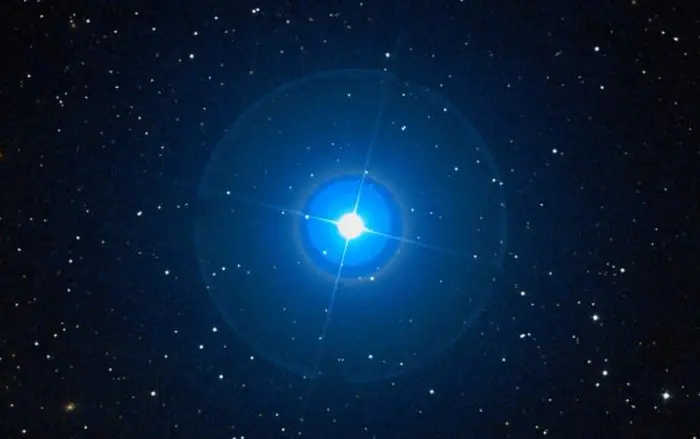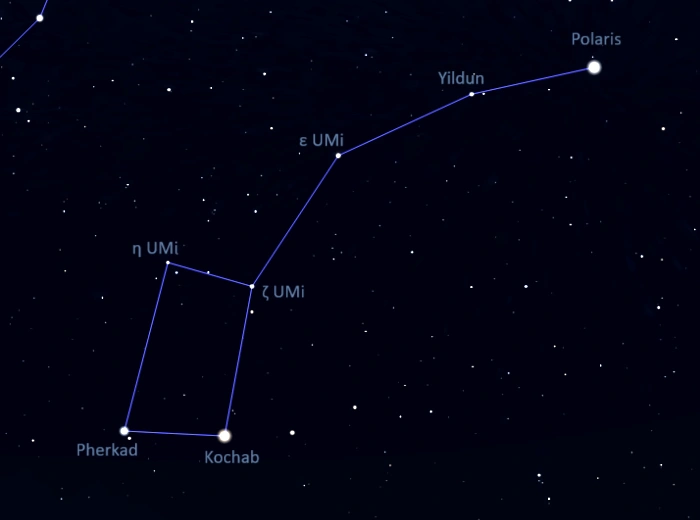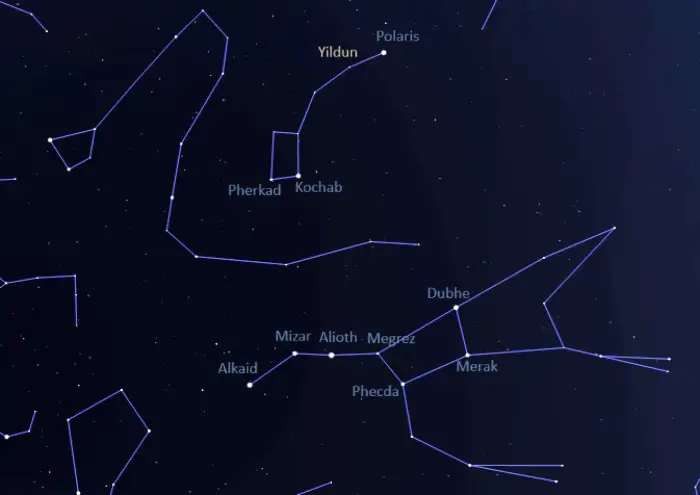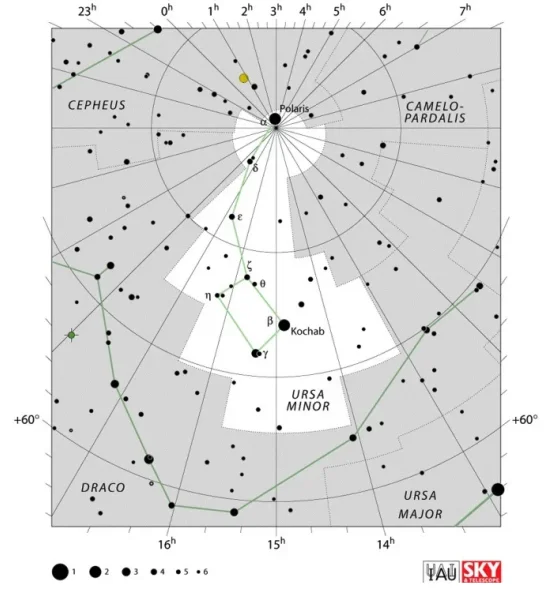Yildun, Delta Ursae Minoris (δ UMi), is a white main sequence star located 172 light years away in the constellation Ursa Minor (the Little Bear). With an apparent magnitude of 4.36, it is the seventh brightest star in the constellation. It appears near Polaris in the sky and is one of the seven stars that form the Little Dipper, an asterism that can be used to find the northern celestial pole.
Star system
Yildun is a white main sequence star of the spectral type A1 Van. It has a mass of 2.35 solar masses and a radius 2.8 times that of the Sun. With an effective temperature of around 9,911 K, it is 47.77 times more luminous than the Sun. The star has an estimated age of 327 million years.
Yildun is a fast spinner. It spins 87 times faster than the Sun. With a projected rotational velocity of 154 km/s, it takes 19 hours to complete a rotation. The rapid rotation causes nebulous absorption lines in the star’s spectrum, indicated by the suffix “n” in the star’s spectral class.
The fast rotation is also giving Yildun an oblate shape. The star is flattened at the poles and has an equatorial bulge. Astronomers estimate that the star’s equatorial radius is 7% larger than its polar radius.
Yildun has a companion located at an angular separation of 4.5 arcseconds. The companion is a 12th magnitude star that shares a common proper motion with Yildun. It has an estimated mass 16% that of the Sun. The projected separation between the stars is 237.4 astronomical units (AU).

Yildun (Delta Ursae Minoris), image credit: ESO/Digitized Sky Survey 2 (CC BY 4.0)
Facts
Yildun is one of the seven stars that form the Little Dipper, a relatively faint asterism that takes up most of the Ursa Minor constellation. Other stars that form the Little Dipper are Polaris (Alpha Ursae Minoris), Epsilon Ursae Minoris, Eta Ursae Minoris, Zeta Ursae Minoris, Kochab (Beta Ursae Minoris), and Pherkad (Gamma Ursae Minoris).
The Little Dipper is difficult to see from light-polluted areas because its middle four stars, including Yildun, are faint. However, Polaris, the nearest visible star to the north celestial pole, and Kochab and Pherkad, the Guardians of the Pole, are relatively bright and can be spotted from urban areas in good conditions. Yildun is the second closest named star to the northern celestial pole, after Polaris.

Little Dipper, image: Stellarium
Polaris, Yildun, Kochab and Pherkad were known as the Dancers, Circlers or Leapers (Ludiones, Ludentes, Circitores or Saltatores) from antiquity well into modern times.
In traditional Chinese astronomy, Yildun formed an asterism called 勾陳 (Gōu Chén), meaning Curved Array, with Polaris, Epsilon UMi, Zeta UMi, 2 UMi, and HD 217382 in the neighbouring constellation Cepheus (the King). The asterism was part of the larger Purple Forbidden Enclosure, which represented the imperial palace.
Name
The name Yildun (pronunciation: /jɪlˈdʌn/) comes from a misspelling of yıldız, the Turkish word for “star.” The International Astronomical Union’s (IAU) Working Group on Star Names (WGSN) approved the name for Delta Ursae Minoris on August 21, 2016.
Location
Yildun is easy to find on a clear, dark night. It is the nearest star in the handle of the Little Dipper to Polaris. At declination 86° 35’ N, the star never appears above the horizon for observers south of the latitude 3° S and is best seen from the northern hemisphere.
The Little Dipper can be found using the stars of the brighter Big Dipper. Polaris lies near the imaginary line extended from Merak (Beta Ursae Majoris) through Dubhe (Alpha Ursae Majoris), the outer stars of the Big Dipper’s bowl. Kochab and Pherkad (Beta and Gamma Ursae Minoris), the second and third brightest stars in Ursa Minor, appear roughly parallel to Mizar and Alioth (Zeta and Epsilon Ursae Majoris) in the Big Dipper’s handle.

The location of Yildun (Delta Ursae Minoris), image: Stellarium
Constellation
Yildun is located in the constellation Ursa Minor. It is the middle star in the Little Bear’s tail. The northernmost constellation in the sky is one of the Greek constellations, catalogued by the Greco-Roman astronomer Claudius Ptolemy of Alexandria in his Almagest in the 2nd century AD. It was introduced by the Greek philosopher Thales of Miletus in the 6th century BC. Thales adopted the constellation from the Phoenicians, who used its stars for navigation.
In Greek mythology, Ursa Minor is associated with Ida, the nymph who nursed Zeus when he was very young, and with Arcas, the son of Zeus and the nymph Callisto, who was transformed into a bear by Zeus’ wife Hera.
The Little Bear is the 56th largest constellation in the sky, stretching across 256 square degrees. With only three stars brighter than magnitude 3.0, Ursa Minor does not stand out in the sky. Its brightest star, Polaris (Alpha Ursae Minoris), shines at magnitude 1.98 and is, on average, the 48th brightest star in the sky.

Ursa Minor constellation map by IAU and Sky&Telescope magazine (Roger Sinnott & Rick Fienberg) (CC BY 3.0)
The Ursa Minor constellation is best-known for hosting the Little Dipper and Polaris, the North Star. Other notable stars in the constellation include the orange giants Kochab (Beta Ursae Minoris) and Theta Ursae Minoris, the A-type giant Pherkad (Gamma Ursae Minoris), the variable red giants Lambda Ursae Minoris, R Ursae Minoris and RR Ursae Minoris, the spectroscopic binary star Epsilon Ursae Minoris, and the variable carbon star Z Ursae Minoris.
The constellation is also home to two notable stellar remnants. The neutron star Calvera (1RXS J141256.0+792204), nicknamed after the villain in The Magnificent Seven (1960), is one of the nearest objects of its kind to the Sun. The white dwarf H1504+65 is the hottest white dwarf known, with a surface temperature of 200,000 K.
Ursa Minor does not host any exceptionally bright galaxies, star clusters or nebulae. Deep sky objects in the constellation include the barred spiral galaxy NGC 6217, the supergiant elliptical radio galaxy NGC 6251, the galaxy Polarissima Borealis (NGC 3172), the northernmost object listed in the New General Catalogue (NGC), and the Ursa Minor Dwarf (PGC 54074), one of the satellite galaxies of the Milky Way.
The best time of the year to observe the stars and deep sky objects in the Little Bear is during the month of June, when the constellation is high above the horizon in the early evening. The entire constellation can be seen from any location in the northern hemisphere.
The 10 brightest stars in Ursa Minor are Polaris (Alpha UMi, mag. 1.86 – 2.13), Kochab (Beta UMi, mag. 2.08), Pherkad (Gamma UMi, mag. 3.05), Epsilon Ursae Minoris (mag. 4.19), 5 Ursae Minoris (mag. 4.253), Zeta Ursae Minoris (mag. 4.32), Yildun (Delta UMi, mag. 4.36), RR Ursae Minoris (mag. 4.44 – 4.85), 4 Ursae Minoris (mag. 4.80), and Eta Ursae Minoris (mag. 4.95).
Yildun – Delta Ursae Minoris
| Spectral class | A1 Van |
| U-B colour index | +0.03 |
| B-V colour index | +0.02 |
| Apparent magnitude | 4.36 |
| Absolute magnitude | 0.62 |
| Distance | 172 ± 1 light years (52.8 ± 0.4 parsecs) |
| Parallax | 18.95 ± 0.14 mas |
| Radial velocity | 17.8802 ± 0.0922 km/s |
| Proper motion | RA: +10.025 ± 0.113 mas/yr |
| Dec.: +54.063 ± 0.102 mas/yr | |
| Mass | 2.35 M☉ |
| Luminosity | 47.77 L☉ |
| Radius | 2.8 R☉ |
| Temperature | 9,911 ± 337 K |
| Age | 327 million years |
| Rotational velocity | 154 km/s |
| Rotation | 19 hours |
| Surface gravity | 4.04 cgs |
| Constellation | Ursa Minor |
| Right ascension | 17h 32m 12.9982131368s |
| Declination | +86° 35′ 11.254580071″ |
| Names and designations | Yildun, Gildun, Vildiur, Delta Ursae Minoris, Delta UMi, δ Ursae Minoris, δ UMi, 23 Ursae Minoris, 23 UMi, HD 166205, HR 6789, HIP 85822, PPM 3067, SAO 2937, BD+86°269, AG+86 240, SKY# 31652, PLX 4158.00, GC 24236, GCRV 10323, GSC 04655-01053, GEN# +1.00166205, FK5 913, ROT 2558, JP11 2943, N30 3970, TD1 21762, TIC 383553764, WEB 14484, uvby98 100166205, IRAS 17483+8636, 2MASS J17321290+8635113, TYC 4655-1053-1, UBV 15437, UBV M 22682, Gaia DR2 1724851173788449536, Gaia DR3 1724851173788449536, DRS 59A, WDS J17322+8635A |